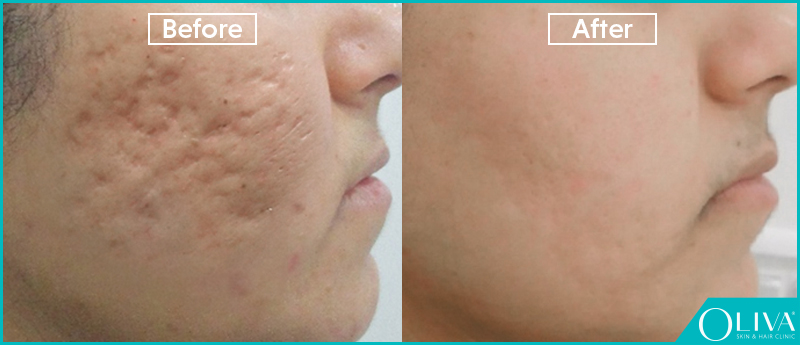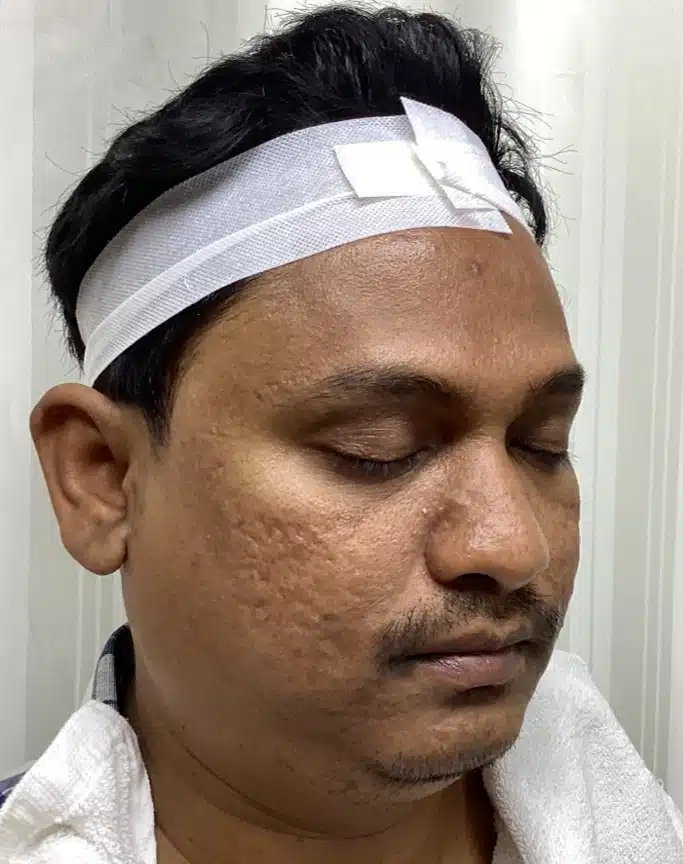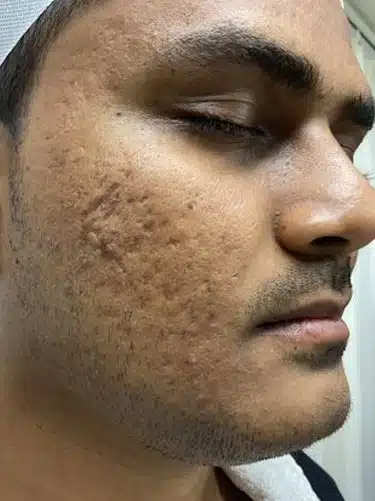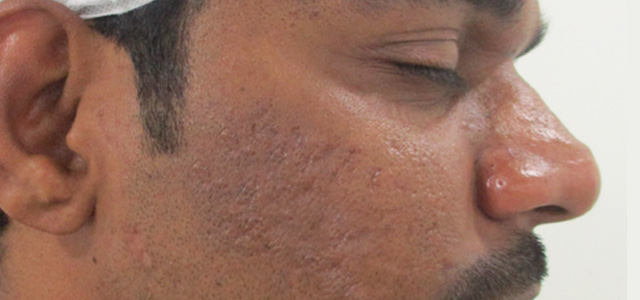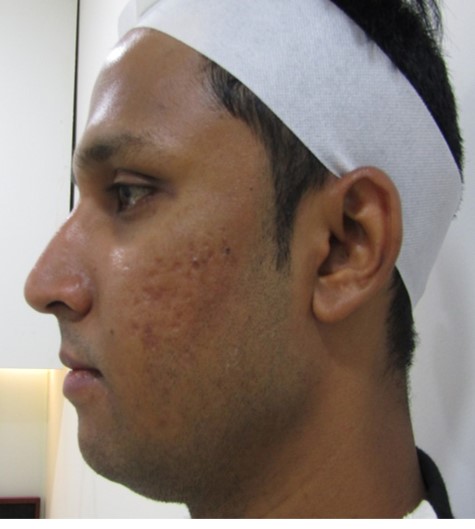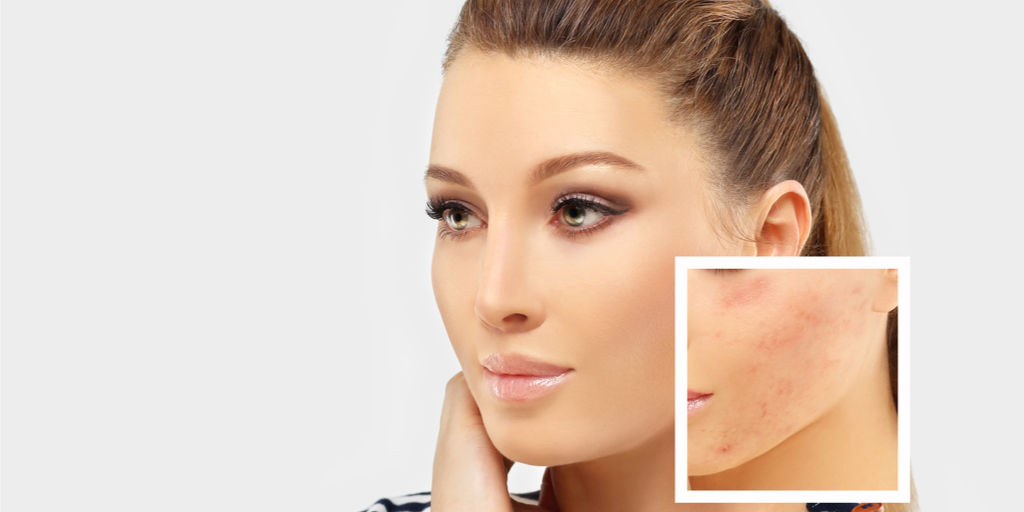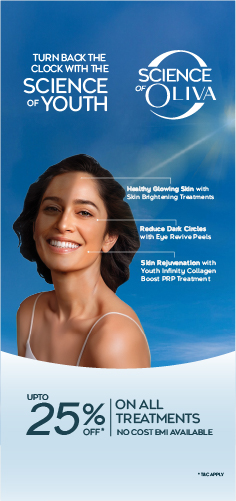In This Article
Rolling Scars Treatment: Cost, Procedure, Results & Prevention Tips
Acne scars can often affect the beauty of the flawless skin you have tried so hard to achieve. Among acne scars, rolling scars with their wave-like appearance can decrease the smoothness of your skin texture, appearing unlike any other skin blemishes and are difficult to get rid of. Read this article to know the science behind why these rolling scars appear. Learn about effective rolling scars treatment and how they can help you improve your skin texture and appearance.
In This Article
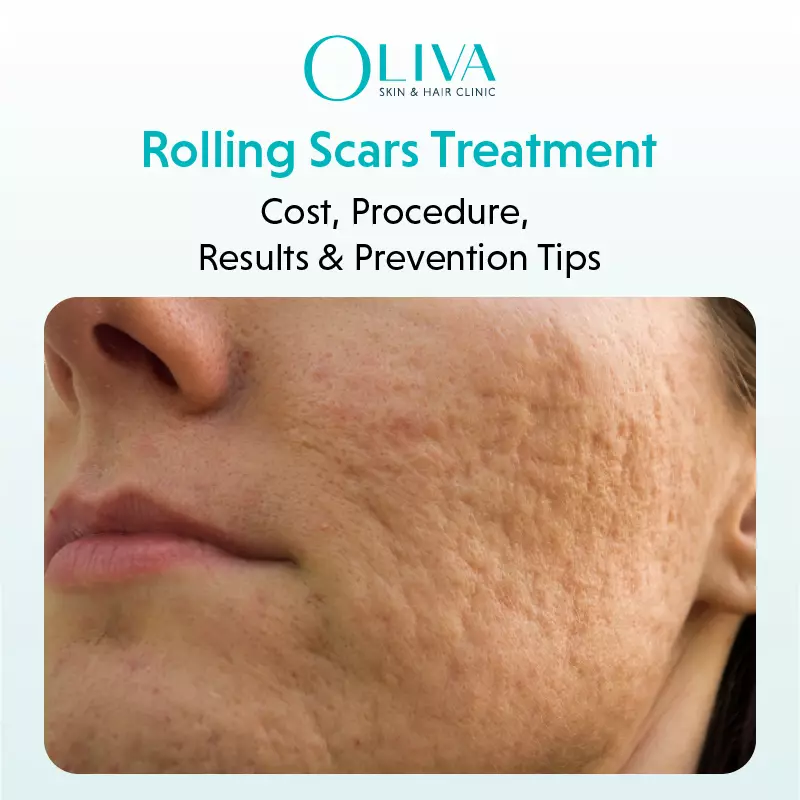
What Are Rolling Scars And How Do They Look Like?
Acne scars can be atrophic or depressed or hypertrophic or raised above the skin. Rolling scars are a specific type of atrophic acne scars with gentle slope-like wavy edges visible on the skin. They can be a few millimetres wide and may not correspond with the size of the acne present before the scarring. They result from abnormal collagen fibre production during the skin healing after an inflammatory acne lesion subsides. They are present where the skin is thick, and the production of fibres may be uneven during healing, e.g. in the lower cheeks and jaw.
What Causes Rolling Scars?
Less collagen is the main cause of rolling acne scar formation. Also, fibrotic bands form below the depressed scar, attaching the overlying skin to underlying subcutaneous tissue, muscle, or fascia, pulling the skin down and increasing the depth of the scar. This leads to the formation of these gently sloping rolling scars.
How To Treat Rolling Scars?
Rolling acne scars, unlike acne marks, do not respond to medications or topical treatments, as it occurs due to anomalies in tissue production during healing. All treatments for atrophic acne scars, including rolling scars, aim to induce the skin’s healing response again to produce new collagen to fill the gaps and smoothen the skin texture.
Treatments for rolling scars include:
-
Laser Skin Resurfacing:
In this procedure, doctors use a laser to remove the top layers of the skin to induce a healing response and produce newer, smoother skin. In addition to the skin, the heat also targets scar tissue, stimulating the process of evaporation. This, in turn, triggers new collagen fibre formation, which gradually fills the depression. The number of sessions required may vary depending on the severity of the scars. Nevertheless, the results are visible after the first session itself. Usually, dermatologists recommend at least 6-8 sessions with a 4-6 weeks gap between sessions. The procedure has a downtime of 5-7 days. However, the results are excellent, gradually reducing scar depth, and promoting new, smooth, brighter skin. Modern Fractional lasers offer a gentler alternative, inducing less trauma to the skin by creating small micro-injuries instead of burning the upper damaged layers. Additionally, the downtime for these procedures is also less at 3-5 days.
Watch the video below to know more about laser skin resurfacing for rolling acne scars:
-
Microneedling Radiofrequency:
This procedure involves creating micro punctures in the skin with tiny needles and administering radiofrequency energy to the lower layers to stimulate collagen and elastin production. These new fibres fill the depression created by acne scars, tighten the skin, and reduce pore sizes. It is effective for scars of all types and severities. However, severe scars may need 6-8 sessions, spaced monthly, for optimal results. Popular for its minimal downtime, this procedure ensures comfort with the topical application of anaesthesia to alleviate any pain experienced by the client.
Here is a detailed video of this rolling scar treatment method:
-
Subcision:
This is a minimally invasive procedure for treating severe rolling scars with underlying tethering. Traditional treatments may not yield the desired results due to the attachment of these scars to the deeper tissues below with a fibrotic band. Dermatologists perform subcision by inserting a sharp instrument like a surgical needle below the scar and severing the fibres, pulling the scar downwards, resulting in immediate enhancement. Following this, the doctor administers additional procedures like laser or microneedling RF to minimise the rolling scars further. Usually, 1-2 sessions are sufficient, with a brief downtime of a few days, characterised by mild pain or swelling.
-
Chemical Peels:
Peeling involves applying plant-based acids to exfoliate the upper damaged layer of the skin and induce new skin and collagen formulation. This process minimises the appearance of scars, marks, general tan and blemishes. Superficial peels containing glycolic acid and lactic acid may not significantly affect rolling scars. Deeper peels with phenol and trichloroacetic acid penetrate deeper under the skin, causing substantial exfoliation. They may work well on mild to moderate acne scars with 5-6 days downtime. Doctors may recommend multiple sessions at a 4-6 weeks gap for optimal results. Although chemical peels may not eliminate rolling scars, they can minimise their appearance.
-
Dermabrasion:
It is a skin resurfacing procedure where the dermatologist uses a special instrument to remove the top layers of skin by rubbing them, producing new, firmer skin from below. This procedure can also induce new collagen and skin tissue formation in the rolling scars, filling the gaps and reducing their visibility. The treatment involves the application of topical or local anaesthesia. It has a downtime of 1-2 weeks, during which the skin heals. Due to its potential side effects like redness, swelling, long-term pigmentary changes, and extended downtime, dermabrasion is not a preferred treatment option.
-
Dermal Fillers:
This treatment involves injecting hyaluronic acid-based “fillers” under the skin. By providing support underneath the scar, it effectively lifts the depressed rolling scars and makes the skin smoother. Results last 1-2 years, after which a repeat procedure may be necessary. It is a safe and effective treatment with minimum downtime.
-
Microdermabrasion:
Microdermabrasion is similar to dermabrasion, but the abrasion and exfoliation are smaller. This procedure uses a diamond tip, or fine crystals to gently exfoliate the skin, resulting in minimal trauma and a less than a week of downtime. Typically performed under anaesthesia, it induces collagen production and promotes new skin formation similar to dermabrasion, minimising the appearance of rolling scars. However, the benefits are lesser and require multiple sessions for significant results. Consequently, it is not the preferred treatment option for rolling scars.
-
Surgical Treatments:
Surgical treatments offer a viable option for severe and unresponsive scars. This can involve complete removal of the scar followed by stitching or surgical lifting. Subcision, as mentioned earlier, is a minimally invasive surgical procedure. Surgical removal or lifting are appropriate treatment procedures for addressing a single scar or a few scars at one time.
What Are At Home Treatments Available?
As mentioned earlier, topical treatments or medicines are ineffective on rolling acne scars. Some individuals attempt using derma rollers at home, which are small devices equipped with microneedles to induce healing response in the skin through micro injuries. However, the method yields limited results, and requires multiple sessions. Moreover, the derma roller needs frequent sanitisation between sessions to prevent infections, which are common due to improper handling and technique.
Before & After Results
Here are a few before-and-after images that demonstrate a significant reduction in the appearance of rolling scars with proper treatment.
How Much Does It Cost To Remove Rolling Scars?
The cost of rolling scar treatment can range from INR 8000 to Rs 19,000 per session, depending on the severity of scars, how old the scars are, if there are any associated skin problems, and the treatment procedure. Multiple sessions of one or more treatments may be necessary, contributing to the overall cost. Consult with an experienced dermatologist to get an exact estimate.
DISCLAIMER:
Please note that the prices mentioned are indicative and may vary depending on the specific treatment, choice of technology, and underlying skin or hair conditions. Prices are also subject to change based on ongoing promotions or offers at the clinic. For an accurate estimate, please consult with our dermatologist.
How To Prevent Rolling Scars?
Preventing acne scars, including rolling scars, is always better and cost-effective than treatment. Follow the steps below to prevent scars:
-
Early treatment of acne:
Any stage or grade of acne can lead to scarring during healing. Consult a dermatologist for proper treatment whenever you notice any acne on your face or body, as early treatment can prevent scars.
-
Hands-off policy:
Touching, poking or scratching your acne can often induce further inflammation and tissue damage, leading to higher chances of scarring. Avoid touching your acne.
-
Sun protection and skin care:
One of the biggest causes of acne marks and scars is an improper skincare regimen, including sun exposure, as UV rays can worsen inflammation, scarring and marks. Use sunscreen, cleanser and moisturiser regularly and avoid direct sunlight to expedite the healing of acne without scars.
-
Consulting dermatologist:
A dermatologist can best help you with medicines and treatments for your acne and scars. Home remedies and self-treatment can often worsen the condition and cause permanent skin damage. Consult a dermatologist early to save your skin from getting scarred!
Takeaway
Now you know all about rolling scars, how they appear and how to prevent and treat them. Follow a good skin care regimen to reduce the chances of inflammation and scarring in your skin. Visit a dermatologist if you have acne or scars. Selecting the proper treatment and following it diligently can help you eliminate those stubborn scars!
Frequently Asked Questions on Rolling Scars
No, rolling scars or any other atrophic acne scars cannot heal on their own without treatment.
No, home remedies are ineffective in treating acne scars, as they lack scientific backing. Most procedures that can treat acne scars are complex and should take place only under a dermatologist’s supervision.
Rolling scar is a type of atrophic acne scar, which is depressed in nature due to loss of tissue.
No, rolling scars do not go away on their own, but they may reduce in appearance and become less visible with proper treatment.
Rolling scars have gentle, sloping sides, while box car scars have straight, sharp edges.
No, rolling scars are not easy to treat. Only qualified dermatologists can treat them using proper procedures and an effective skincare regimen; even then, complete removal may not be possible.
The time it takes for rolling scars to fade depends on their severity. Moderate to severe scars need at least 6 months of treatment for good results.
Retinol cannot help heal rolling scars alone, but it can improve the treatment results if used in conjunction with in-clinic procedures as recommended by your dermatologist.
You can reduce the visibility of rolling scars but may not get rid of them completely.
https://acne-scar-treatment.com/rolling-scars/Our certified subject matter experts do extensive research and collate facts from reputed scientific journals and international studies to create informative and engaging articles related to all your dermatology concerns. They strive to help you decipher medical jargon, distinguish fact from fiction and overcome paranoia. Our qualified medical board or expert panel goes a step further to verify these facts based on their rich academic knowledge, vast clinical experience and critical industry insights to ensure you consume only medically accurate content that empowers you to make informed decisions about your hair and skin-care treatments and weight management. Check out our Editorial policy for further details.
https://acne-scar-treatment.com/rolling-scars/
https://www.webmd.com/skin-problems-and-treatments/acne/what-to-know-about-rolling-scars




